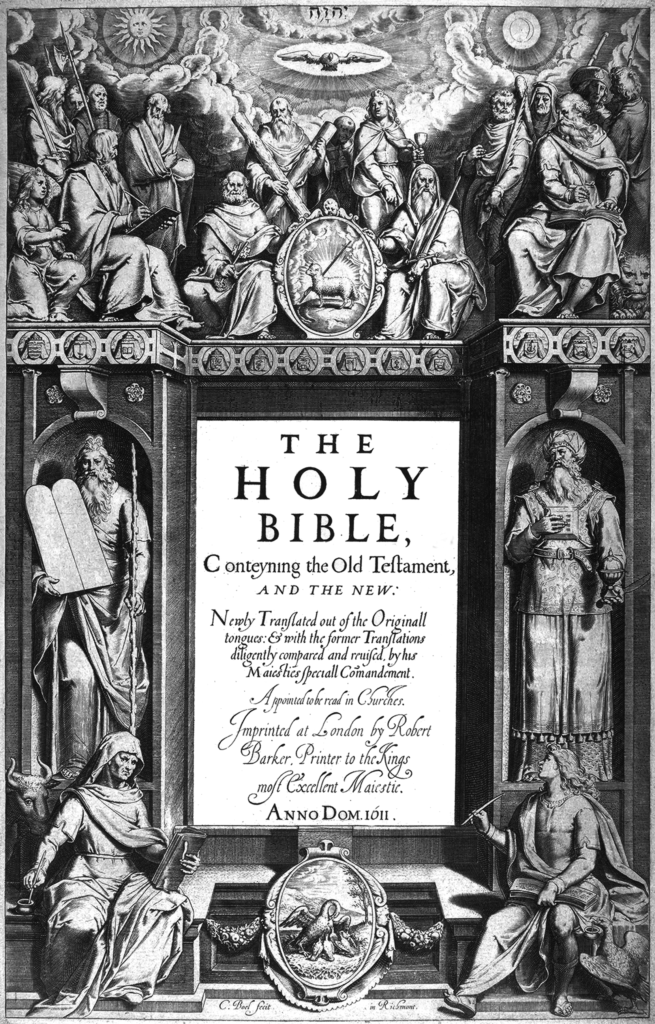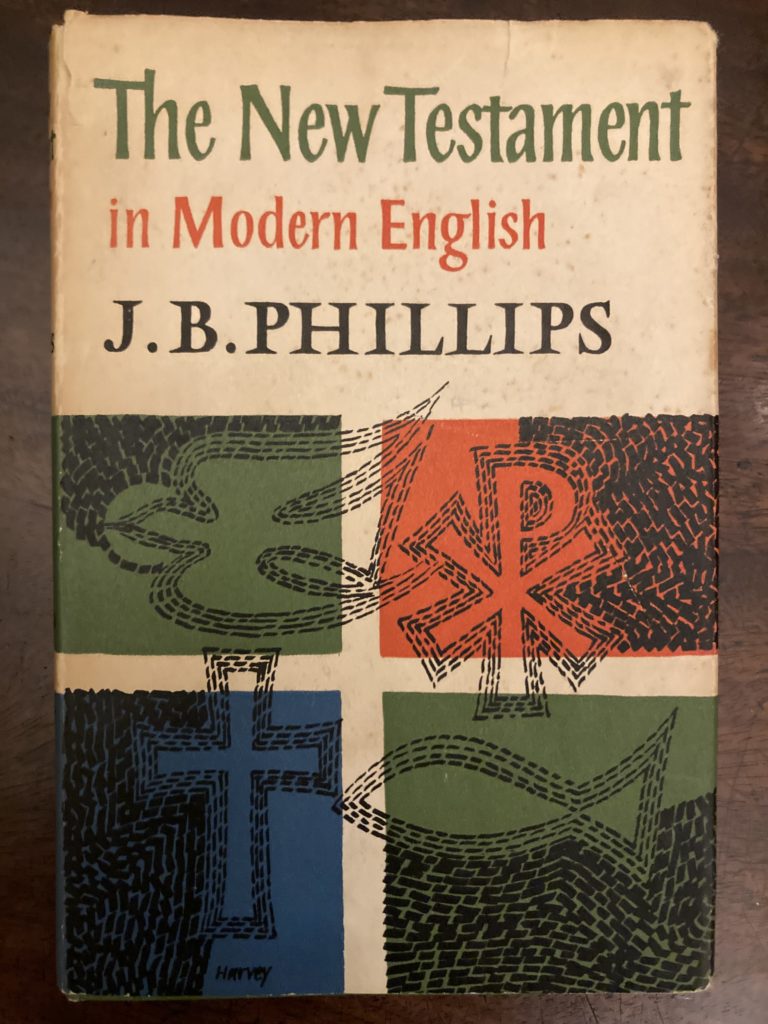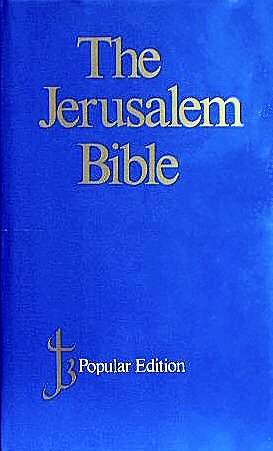
THE NEW ENGLISH TRANSLATION
AND ALL THE REST!
MY LIFE WITH THE BIBLE
When I was born there was in effect only one translation of the Bible normally available, the Authorised Version of 1611 (AV), a wonderful poetic translation using the best scholarship of the time. When I was seven the Revised Standard Version of the whole Bible was published, a literal but readable translation which quickly became popular in schools.
First edition of theAuthorised Version 1611

The English vicar J B Philips made a much more readable translation. When I was two he brought out ‘Letters to Young Churches which at last made Paul’s epistles understandable. E.g. “The Jews ask for miraculous proofs and the Greeks an intellectual panacea, but all we preach is Christ crucified – a stumbling block to the Jews and sheer nonsense to the Gentiles, but for those who’re called, whether Jews or Greeks, Christ the power of God and the wisdom of God.” A well known passage to which Philips brought his flashes of brilliance. He published a revised whole New Testament in October 1960. I bought a copy from the first reprint – in October 1960!

Three years later the New Testament of the New English Bible appeared. I remember in RE we compared the first chapter of John as printed in the press with what was in our own Bibles. We could hardly make head or tail of it – until we realised that the newspaper quotation was from the First Letter of John, not the Gospel of John!
Five years later, when I went up to read history at university, the Roman Catholic Church made a very modern translation of the Bible, the Jerusalem Bible. There was even an edition in which they printed teh books of the Bible in chronological order of writing. It is the normal translation for the readings in the mass.
Five years after that a modern paraphrase came out called ‘the Living Bible’. As an example, Ecclesiastes 9.8 (RSV) “Let your garments be always white; let not oil be lacking on your head’ became ‘Wear fine clothes – with a dash of cologne!’
The most accurate translation is the Revised Version, a scholarly retranslation of the 1611 Authorised Version, which appeared in 1889. I started studying theology at Durham University in 1982 and there was a small protest by us students about using the RV. As a result of which we were able to use the RSV, a bit more readable. When I was ordained deacon, I was given the RSV New Testament. When I was priested a year later, I reveived the New International Version, published 1978.
THE STORY CONTINUES
Since then the number of Bible translations has blossomed until now there are over seventy translations to choose from.
A major change has been replacing gendered language, such as:
‘Blessed is the man that walketh not in the counsel of the ungodly,
nor standeth in the way of sinners.’ (Psalm 1.1, Authorised King James Version).
In the New International version it now reads: ‘Blessed is the one who does not walk in step with the wicked
or stand in the way that sinners take.’
But that is not the real reasons for so many modern translations. There are more than sixty English translations of the Bible available in biblegateway.com. The reason is that every single translation is a compromise between sticking close to the original text (formal equivalence) and readability (functional equivalence) – and readability also changes depending on the audience, e.g. Times readers vs Daily Mirror readers.
However in 2006 a new kid appeared on the block, the New English Translation, one which I have only just discovered. It is a game changer.
NEW ENGLISH TRANSLATION

Philadelphia
The New English Translation – NETbible.com – was conceived at the annual meeting of the Society for Biblical Literature in Philadelphia in November 1995. They wanted a Bible fit for the digital age. A team of more than twenty biblical scholars worked with the original Hebrew, Aramaic and Greek texts, and produced a faithful and readable version. So Ecclesiastes 9.8 reads, ‘Let your clothes always be white, and do not spare precious ointment on your head.’
Apart from being a nice translation, it has two unique features.
COPYRIGHT FREE
The NET is not only free (because being on the internet), it is also copyright free. Which means you can quote very large passages without having to pay for copyright, as I was when I produced ‘The Book of Job for Public Performance’. I have also toyed with the idea of producing a performance version of the Song of Songs. So now I don’t have to choose between using the Authorised version (1611) or paying copyright. Good News!
FOOTNOTES!!!
What gets me very excited about NET are the footnotes – all 60,932 of translators’ notes. And not just the fact that they are there, but they are very easy to use. You click on one and instantly go to the footnote, no scrolling down to the end of the chapter. Some footnotes are a clarification of a single word, e.g when they translate the Greek ‘kai’ (and) as ‘but’. Others are lengthy explanations or a virtual commentary. Here are a handful of examples:
Genesis 1.1. To start at the beginning, there is a long footnote on the word ‘God’. Famously, the Hebrew is plural – ‘Elohim’. The footnote tells us that the plural is sometimes used to denote an abstract concept, which would fit, and that when they use it to refer to the One God, the verb that goes with it is singular. Helpful!
Proverbs 3.1-2. My child,[b] do not forget my teaching,
but let your heart keep[c] my commandments,
for they will provide[d] a long and full life,[e]
and well-being[f] for you.
I checked up on the word ‘well-being’ and found it translates the Hebrew ‘shalom’.
So much richer than the English (and Greek) word ‘Peace’ which we use during communion services.
Luke 9.48 The disciples were arguing as to who is the greatest among them. Jesus brought a child to stand by him and says that whoever welcomes a child ‘is the greatest’. (NIV, NRSV, Good News). The footnote tells us the word I ‘magma’ or ‘great’, not ‘greatest or greater. Unlike the disciples, Jesus does not get into the game of making comparisons. There ’s a sermon in that! (The AV and RSV both get it right).
John 15.17 This[as] I command you—to love one another. The footnote tells us that what Jesus said was ‘These(things) I command you – to love one another.’
Was there more than one commandment to love one another? Something to think about.
A CAVEAT (WARNING)
So now the NET is my go-to translation on biblegateway.com. But it does not always get things right. So in John 2.19, where Jesus responds to the Jewish elders’ protests about turning out the money changers from the temple, Jesus says ( in the NET), “Destroy [an] this temple and in three days I will raise it up again.”
Except that he didn’t. The word he used, in Greek, was ‘naos’ which means ‘the inmost part of a temple, the shrine.’ I.e., the holy of holies, the place where there the awesome presence of God lives. The right translation matters!

Even with the excellent footnotes of the NET, I think you still need to have an interlinear Greek/English New Testament, alongside a Greek Lexicon of the New Testament. Or have access to someone geeky enough to own them!
